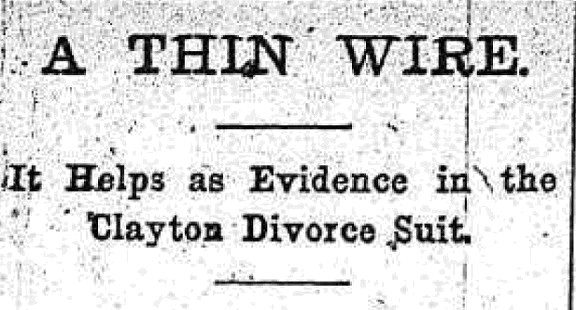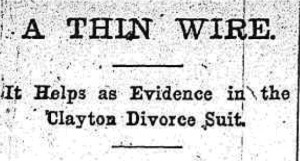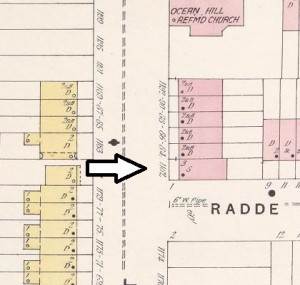Hijinks on Herkimer, Pt. II


(To see Pt. I of Hijinks on Herkimer)
It was not too long before, on one specific occasion, Wolfram took notice of Clayton approaching and entering their apartment building. Wolfram must have had a mouse’s ear, because he discerned from the top floor of the building that Ransom had not come upstairs but had entered an apartment on one of the first two floors. Wanting further evidence against Mrs. Oakley, Wolfram slipped down the stairs and went around the side of the house and “walked slowly by” the windows attached to Mrs. Oakley’s apartment, one of which belonged to her bedroom. As the blinds to the flat were “just a little open,” Wolfram peered though and saw the married man, Ransom, in Mrs. Oakley’s bedroom, a scandalous show of moral laxity at the time.
Two nights later, Wolfram viewed Ransom returning to the apartment building and, subsequently, to Mrs. Oakley’s apartment. Wolfram must have drawn murmurs from the gathered crowd in the courtroom when he said what he observed next: Ransom did not depart Mrs. Oakley’s apartment until 6 am the following day.
Determined, on the third try, to get the evidence that he needed to have Oakley banished from his building, Wolfram decided he would convince himself once and for all that what he had seen was enough to have her removed. Going out into the house’s front yard, he took a piece of thin wire with him and “fastened it to the gate so that when it was opened the wire would be broken.”
At 5 a.m. the next morning, the article noted, “Wolfram was up and out at the gate.” The wire was not broken. An hour or so later, Wolfram noticed Ransom leaving the house.

Wolfram, as good as any detective in the day, even went so far as to track Mrs. Oakley “from one place to another night after night.” The article noted that Wolfram “omitted not the slightest detail, even as to the exact time,” eventually noting that he tracked her to “a beer garden in the Twenty-sixth ward” which, he felt, “had a shady reputation.”
When asked by Mrs. Clayton’s attorney to tell him what type of reputation Mrs. Oakley had in the building, Mr. Wolfram did not hesitate.
“A very bad one,” he replied. “She was dispossessed for having too many visitors. I have often seen men leave her flat early in the morning.”
Another renter in the building, Silas Brink, was a Civil War veteran and a drum major of the B.F. Middleton Post, No. 500, Drum and Fife Corps, of the Grand Army of the Republic (G. A. R.). Brink had also “peeped” into Mrs. Oakley’s bedroom and saw Ransom therein, further, and more shockingly, testifying that Mrs. Oakley had “tried to induce his youngest daughter to go to her apartment and assist her in entertaining her visitors.”
In these Victorian times, such behavior was an unacceptable breech of public etiquette and morals. But Mrs. Oakley had previously been found not guilty, and so the questions on everyone’s lips were: Was it reasonable to assume that Ransom, too, would be found not guilty? Had they felt sorry for Mrs. Oakley? Would that pity transfer to Ransom, as well?
Finally, the last of the plaintiff’s witnesses appeared. One of Ransom’s sons, Walter F. Clayton, took the stand. He testified briefly to having served the summons and complaint on his father. Now, it was evident that even Ransom’s own issue had found his behavior wanting.
The deliberations did not last long since the senior Clayton had not found it worth his while even to show up to defend himself. With all of the evidence against Ransom, Mrs. Clayton was granted her decree as well as the custody of their minor children.
After the court case ended, Ransom and his son, Walter, would dissolve their building partnership, Ransom F. Clayton & Son. A year later he would marry a woman younger than his son, moving with her into an apartment in Park Slope. A few years later he would find himself invalided and receiving his Civil War pension. And in 1907, Ransom F. Clayton would be lying in Cypress Hills Cemetery.
———————————————————————————————————————–
This story was composed from research conducted by The Brownstone Detectives. Let us do an in-depth investigation of your house and its former owners and produce your very own House History Book. Your hardbound coffee table book will include an illustrated and colorful narrative timeline that will bring the history of your house to life. Contact us today.
[…] part II of this court drama in tomorrow’s Brownstone Detectives […]